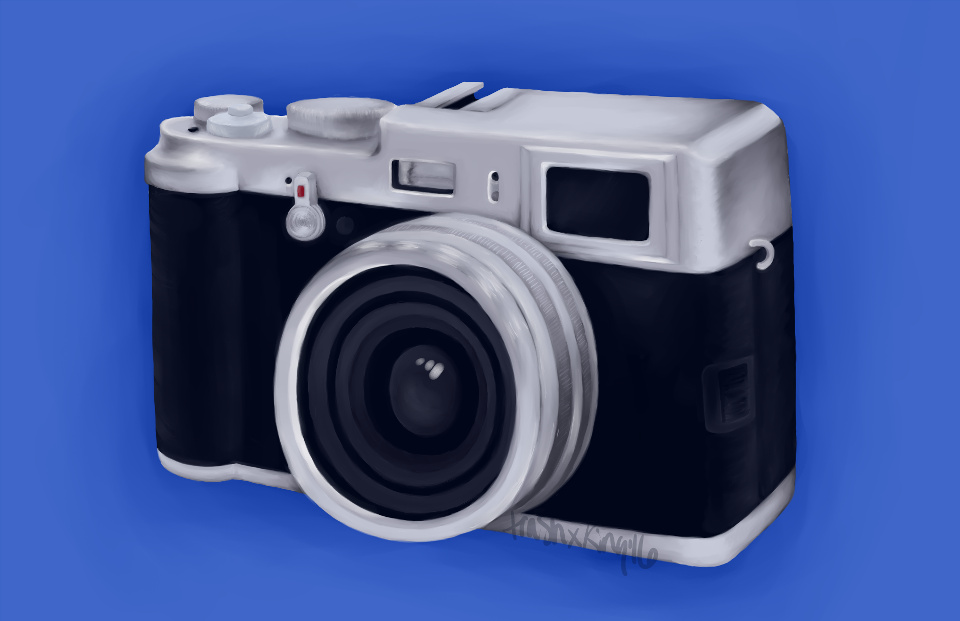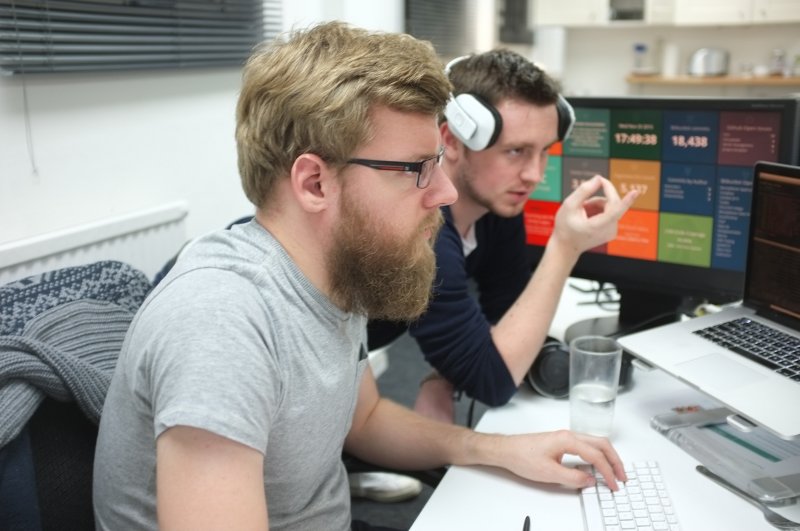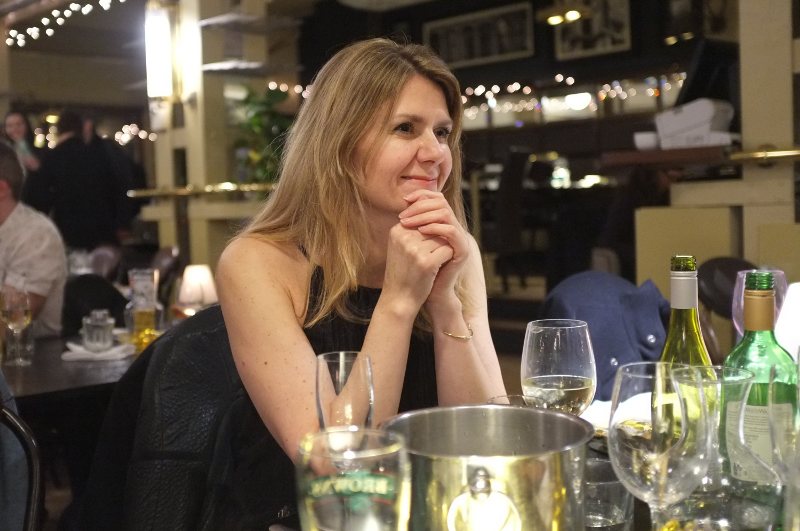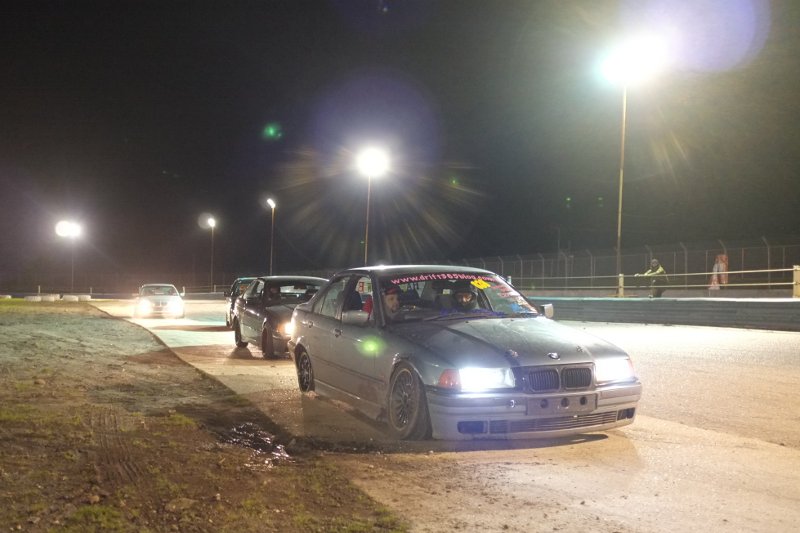
X100, artwork by Tyberius Anderson.
from Shutter, by Lewis Collard
Article first written 2018, updated in 2021 for my second X100.

X100, artwork by Tyberius Anderson.
I wanted to love the X100. I was elated when it came out in 2011. I'd always wanted a camera that had an SLR-sized sensor, a fixed lens, and real shutter and aperture dials. Of course I waited for a few years for them to become cheap on the used market, so I bought this for £350 in 2015.
I ended up selling my first one; I ragequit the X100 after an incident wherein the AF system got hung up under not even slightly tricky conditions. I eventually bought another one, because there's nothing in the world quite like it, despite its flaws.
X100 fans will hate my nitpicking. Just bear in mind nothing I hated about it stopped me from using it, and it is a camera I regretted selling every time I spotted a potential shot in dim artificial light.

Dan and Dan, fluorescent lighting, 1/60 at f/2 and ISO 200.
The X100 is styled like a 1970s rangefinder camera. Everyone who sees it is surprised when they find out that it is is a digital camera.
Of course I completely dig this, but even if you don't love 70s rangefinder cameras, it works in your favour for people shots because it looks much less intimidating than an SLR camera – and, because it's so small compared to an SLR, you're more likely to bring it with you.
The X100 is built very well, and it is made almost entirely of metal. The only let-down is the battery/memory card door; this is plastic and it feels out of place. There are no electrical connections on the battery door itself, so if this breaks, you will still be able to use the camera.
Despite being so well-constructed, it is miraculously light; it weighs only a few grams more than my Olympus Trip 35. My plastic Nikon F55 film camera fitted with a plastic 50mm f/1.8 lens, which is as light as SLR cameras can reasonably be, weighs about 50 grams more than the X100, and it is a lot less compact.
Battery life is not great, especially if you use the digital overlay on the optical viewfinder a lot. I got less than 300 photos on a charge on a known-good battery. I got even less than that on a dodgy aftermarket one, but that's my problem and not the X100's.
This isn't even terrible for compact cameras; I've just been spoiled by using a camera that does five thousand or more on a charge.
You won't mind carrying spare batteries, as its batteries are so small.
The X100 is as quiet as a camera with a physical shutter can be.
The X100 has a leaf shutter that makes nearly no noise. It is quieter than my 1954 Voigtlander Vito B, which itself is so quiet that it makes a Trip 35 sound loud, and the Trip 35 is so quiet that any SLR sounds like a plane taking off in comparison.
If you think the X100 is too quiet, you have three different fake shutter sounds to choose from! Interestingly, Fuji's manual describes this as allowing you to "[c]hoose the sound made by the shutter", which is almost the opposite of what this setting does.

Wine glasses, halogen lighting, nice neutral colours. ISO 400, f/2, 1/30.
I love the dedicated aperture and shutter speed dials of the X100. I love even more that they work like old Pentax film SLRs: set both aperture and shutter speed dials to A if you want to have fully-automatic exposure, take either one of them off A to set aperture or shutter priority, and set both to A for a fully manual exposure. This makes much more sense to me than the "modes" of almost every other digital camera.
There is a dedicated exposure compensation dial, which is great.
I have spent far more time and taken far more photos with Nikon SLRs than I have with the X100,
and I have the "hold
When you are transporting the X100, all three of these controls tend to get knocked out of where you left them. This doesn't matter, because you can reset them easily even with your eyes closed.
I don't know how I manage it (though it's probably because I am an incorrigible fidget), but somehow I manage to nudge the drive mode button while I am transporting it, and engage the X100's weird drive modes. You can read about those under "Party tricks" below.

Jake at the Willoughby Arms.
Dim CFL lighting, 1/30 at f/2 and ISO 3200.
The rear control button has a shallow, hard 'click' action like a compact camera, so it's hard to use by feel with numb fingertips, clumsy fingers (mine), or with gloves. I much prefer the big squishy buttons of Nikon SLRs.
There is no ISO button; you need to set ISO in a menu. You can assign the Fn button to change the ISO, but that only pops up the ISO menu; you still have to poke the rear controls to set it. This wouldn't matter that much if the X100's auto ISO worked properly, but it doesn't use speeds higher than 3200, so I occasionally find myself setting this manually under really dim light.

Nicky, Brown's. Mixed halogen and CFL lighting, 1/60 at f/2 and ISO 3200.
The fixed lens is fantastic.
I love the fixed 22mm focal length. It's about the same equivalent focal length as a Konica C35, Olympus Trip 35, or any other classic fixed-lens 70s rangefinder camera. For people snapshots this focal length is perfect; it's wide enough that you can happily use it at close range without being so wide that you lose your subject in a sea of surroundings. For stills, it's just wide enough to give a pleasant exaggeration of perspective compared to a 50mm lens.
At the 12 megapixels of the X100, this lens is impeccably sharp. It is super-sharp, at every aperture, everywhere in the frame. This is the most consistently sharp lens I have ever used, including lenses that cost more than this camera did new. There is never any need to stop down for sharpness; it's as perfect at f/2 as lenses have ever been.
The X100's lens can focus on things very close to the camera. You'll want to enable the X100's macro mode to do this. While Fuji claims the X100 should be able to do close-focus without macro mode, the X100's autofocus usually gets confused and gives up.
I've never noticed any distortion in the real world. There is a tiny bit of barrel distortion, which I only know because Darktable (via Lensfun) has a profile to correct it, not because I noticed it in real photographs.

James, Kingston Arms.
Dim winter afternoon light from the window, 1/100 at f/2 and automatic ISO
400.
The X100's auto white balance gets great colour and skin tones under any kind of weird artificial lighting. Check it:

George, 1/60, f/2, ISO 250.
This was with different coloured fluorescent lights lighting the shot (one a green/yellow, one slightly more reddish). On top of that, there was an incandescent modelling light from a professional photographer's strobe light in the background, shining onto a neutral-grey and white surface to confuse the camera's white balance algorithms even more.
It'll even do its best to get good pictures under light for which complete colour correction is impossible, like CFL bulbs.
Its auto white balance does not make any difference if you are shooting raw, of course. I shoot raw + JPEG with the X100. I like how the X100's straight-from-the-camera JPEGs look for photos of people, but I prefer tweaking raw files for other subjects. It's less effort to always shoot raw + JPEG than it is to change a setting when I change the subject.

A train. 1/60, f/2, ISO 800.
This was "developed" from a raw file with Darktable;
the JPEG straight from the camera actually had more neutral colour than this,
and actually looked better because the X100's denoising works better than Darktable's,
but sometimes I like making work for myself.
Low-light performance is awesome. The combination of a fast f/2 lens that loves being shot wide-open, excellent auto white balance, and awesome high-ISO performance means you can get photos under ridiculously dim lighting without flash.
The auto ISO control only goes up to a maximum of ISO 3200; if you want a higher ISO than that you have to set it manually, which involves poking around in a menu. If the X100 looked horrible at 6400 I could understand locking it out, but 6400 on the X100 looks plenty good enough.
The X100's noise reduction at high ISOs is excellent. You will only get the full benefit of this if you are using JPEGs straight from the camera. If you shoot raw, as most of you lot do, this noise reduction is not applied.

Owen Gibbs, Swaffham Raceway. Stadium (presuming metal-halide) lighting,
1/125 at ISO 3200 and f/2, flare from a Hoya HMC UV filter that needed a clean.
Autofocus is fine for anything in bright to moderately dim light, if your subject stays still.
When it hits, it's accurate, but focusing is slow compared to any SLR, and the X100 hunts a lot more than my SLRs do under very dim conditions.
Continuous mode (AF-C) is silly; it keeps focusing even after you stop half-pressing the shutter button, unlike every other autofocus camera. I've not been able to coerce it into doing anything useful.
Even the manual warns that it's unable to shoot rapidly-moving subjects, which makes you wonder why the X100 has AF-C at all.
When using the finder in combined optical/electronic mode, the silly AF-C mode gives you the most accurate display of the current autofocus point; it gives you a cross-hair in the finder whereas AF-S and M give you a rather-too-large rectangle. You can change the size of the AF rectangle for AF-S mode, but it only changes the size of the rectangle when the finder is in electronic mode.
Manual focus isn't very fun to use. The focus ring on the X100 is electronically, rather than mechanically, coupled to the focus mechanism in the lens, which makes it awkward and slow. You can hit the AF/AE-L button on the rear to autofocus it, which works fine. Unfortunately, the focus area rectangle is too large and you cannot change it regardless of viewfinder mode.
None of this makes sense, and all considered, the autofocus system of the X100 is much worse than any other serious camera.

Bar guy, Willoughby Arms.
Halogen lighting, 1/30 at f/2 and automatically selected ISO 320.
The X100 is not designed for shooting anything that requires frame rate. The X100 chokes up after a few shots, whereas even my decade-old D2Hs will cheerfully shoot hundreds of photos in less than a minute and always be ready for the next one.

My brother's very very green E30. 1/800, f/2, ISO 200,
raw file processed with Darktable.
The X100 can shoot video. I tried it once, and thereafter only shot video by accident. I have never attempted serious video shooting, so I cannot offer meaningful opinions on how well the X100 does it.
It has a built-in panorama stitching mode; it assists you in taking a series of photographs and it will stitch them together in-camera. I've only used this by accident, but it could be fun!
The X100 has a mad ISO-bracketing mode. It's another feature I've only turned on by accident! I call this mode mad, because it extracts multiple exposures from a single activation of the shutter. I don't know how it works. For all I know, you could probably use this to do HDR compositing without the tiny misalignments & parallax errors you'll get from taking three separate photos at different exposures. Regardless of the quality setting you are using otherwise, this will always output three JPEGs, and not raw files.
The X100 has a small amount of internal memory, which can be your emergency "I forgot my memory card" fallback. It will hold one raw file, or about four "Fine"-quality JPEGs. It is not large enough to hold a raw file and a JPEG. I shoot raw+JPEG much of the time, so the internal memory didn't save me the last time I forgot to put my card back in the camera.
The X100 does not put a disk label on its SD cards when it formats them. Under Linux, this causes them to show up as "DISK" or "32gb volume" when you plug them into your card reader. It'll show up as something equally meaningless on other operating systems.
I haven't discussed the X100's flash performance here, because my second X100 is faulty. The flash never charges, and the camera locks up while it is attempting to charge.
No camera, other than the X100S, X100T and X100F that replaced it, is comparable to the X100.
If you want something like a Fuji X100, your choices are the Fuji X100 or one of its descendants. The combination of being small enough to fit in a pocket, being light enough that you won't notice it, having an SLR-sized sensor and having a fast, fixed lens is not done by any other digital camera.
Actually, the closest thing to the X100 would be any of the legendary 1960s and 1970s 35mm rangefinder cameras, but they don't give you a clean ISO 3200.
I don't count the various Leica digital rangefinder cameras, because I am not convinced they exist. Have you seen anyone actually using one?
SLRs are for shooting things that move, and when a split second decides whether you've got the shot you want or not. Any digital SLR operates much quicker than the X100.
All digital SLRs power on instantly, whereas the Fuji is like a compact camera that requires a second or so to wake up.
All digital SLRs are also much bigger and heavier, which means you're less likely to have them with you! The X100 beats anything that you left at home.
Get one of these as a little camera to carry with you everywhere - and especially if you think you're going to find yourself under artificial lighting, and especially under dim and weird artificial lighting like CFL ("energy saving") bulbs, fluorescent lighting, and who-knows-what-random-colour-temperature LED lighting.
I worry that I upset X100 fans with my nitpicking. None of the stuff I complain about stopped me from carrying it everywhere and shooting it all the time. Even when I ragequit the X100, I couldn't be without one and ended up buying another. The technical image quality was, and 11 years later still is, so good that I cope with its silly flaws.
When I first bought one in 2015, after they had dropped to about £250, I assumed they were going to drop in price forever, because electronics become worthless after about a decade. I was wrong! They still sell for about £250 in 2021. That shows that it either has a cult following, or that they are indeed still extremely viable cameras a decade after their introduction. I hope I have showed the latter.
TL;DR: 'Eject' (Mac) or 'Safely remove' (Windows) your SD card before removing it from your computer, and don't share cards between cameras.
This problem caused me much dismay for some time, so I'm putting it here to save anyone else tearing their hair out.
When I put a 32gb SD card into a Macbook's SD card slot, removed it from the Macbook, and put it back into the X100, it would cause the X100 to take about ten seconds to boot up. I thought my X100 was broken, but it was not. It only happens if you do not software-'Eject' the card before physically removing it.
I worked this out thanks to this thread, though I should have guessed this by the fact it didn't happen on another Mac operated by someone less sloppy than myself.
The nice folks in that thread speculated that Macs create hidden files or otherwise alter the file system in a way that confuses the X100 - alterations which get removed when you "Eject" the card.
Other people claim to have solved the problem by buying the latest, greatest and fastest SD cards. That means I just saved you a few quid, because the pseudo-branded "Transcend" cheapie that came with my first X100 worked just fine and didn't have the slow startup problem after I stopped being sloppy. You're welcome!
Someone should tell me whether this happens on Windows; it doesn't happen on my Linux boxes. In fact, it might not even happen on Macs these days; I had one in my day job from 2015 to 2019 and haven't used one since.